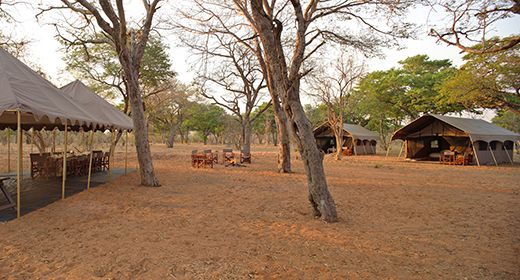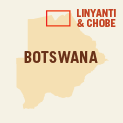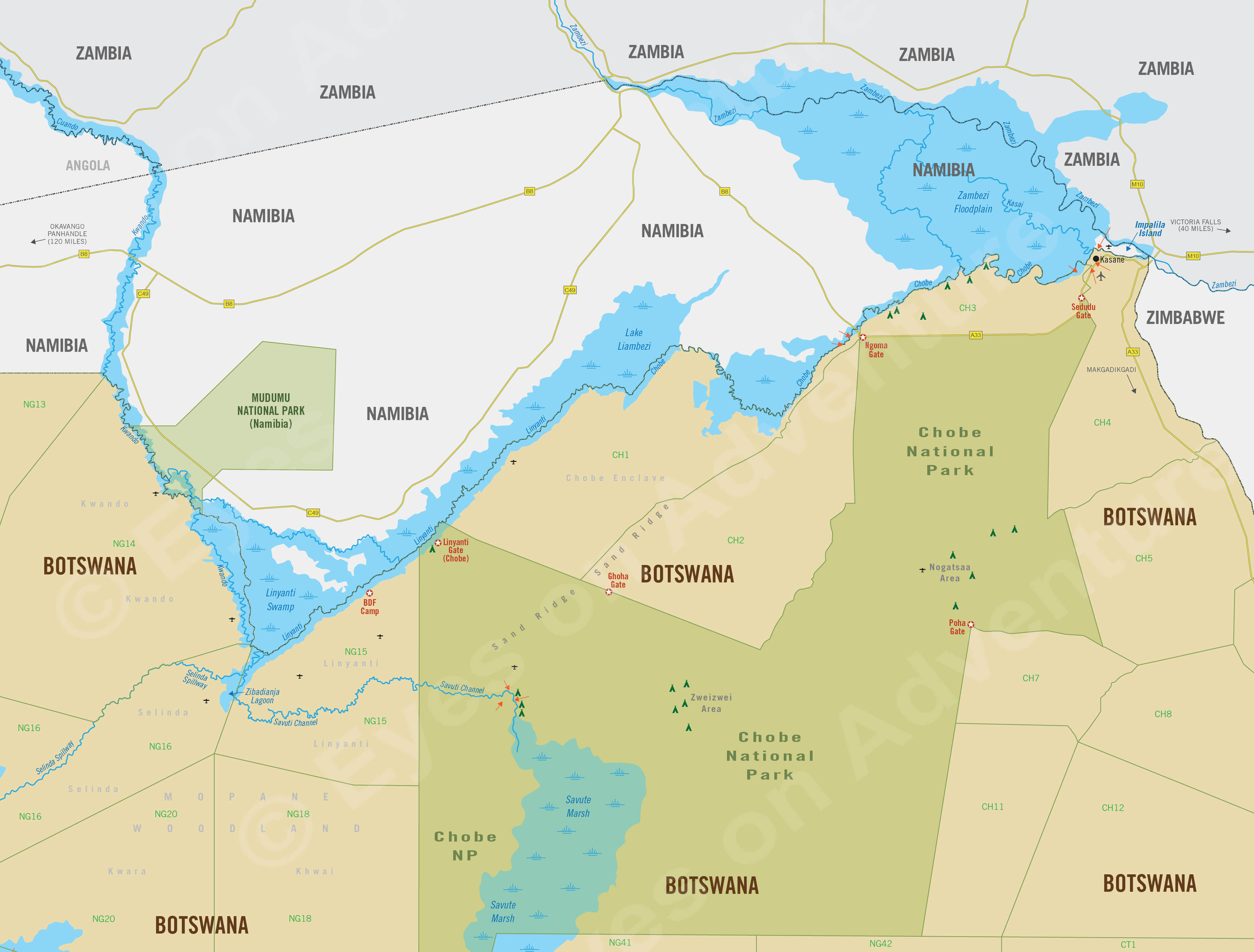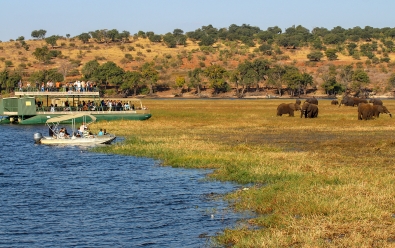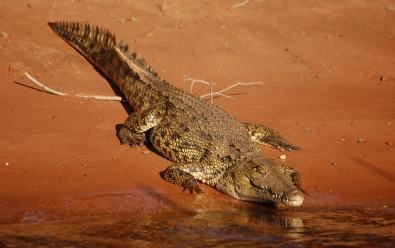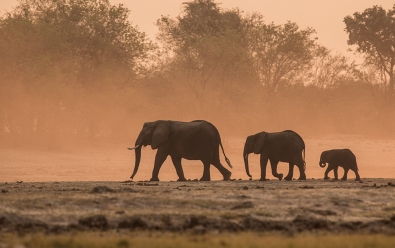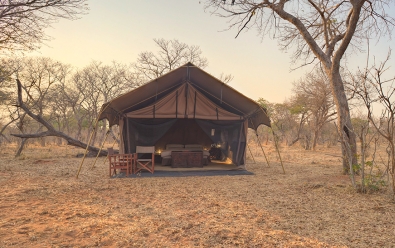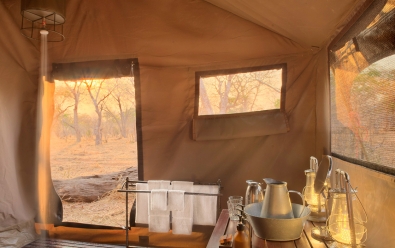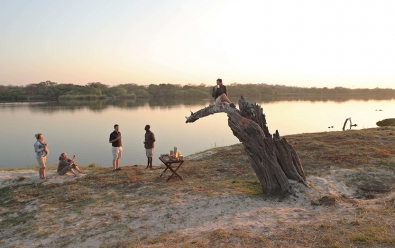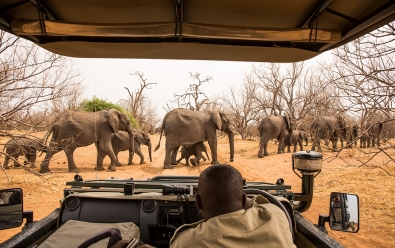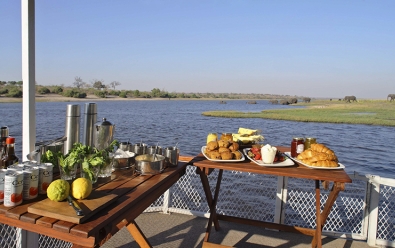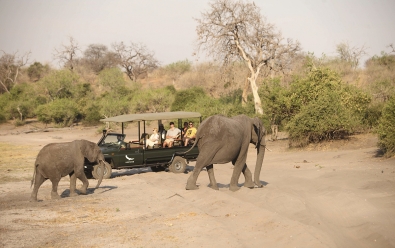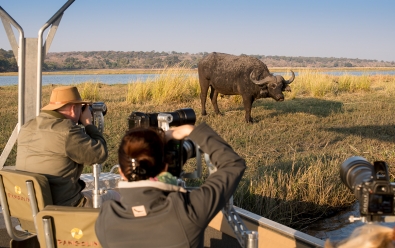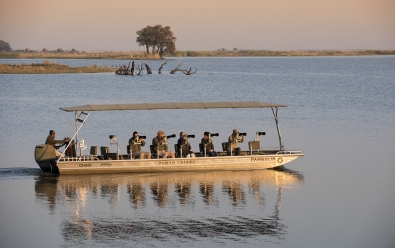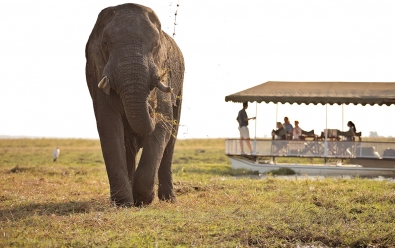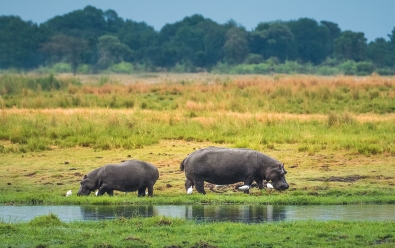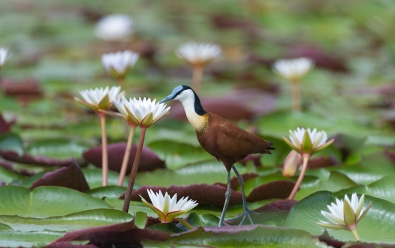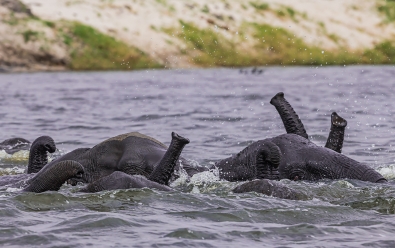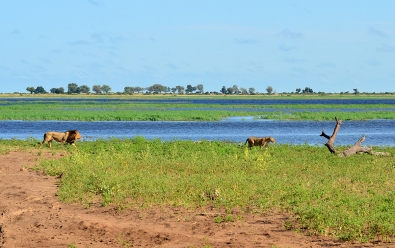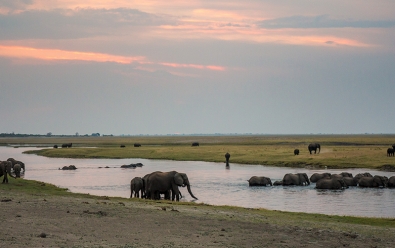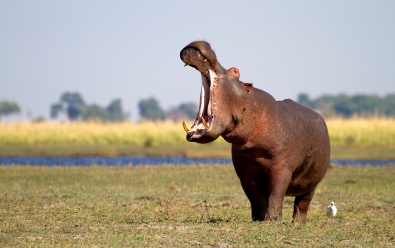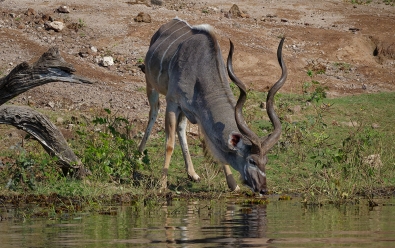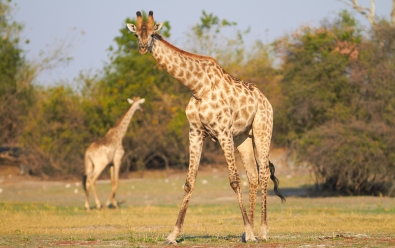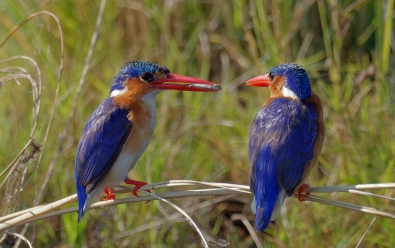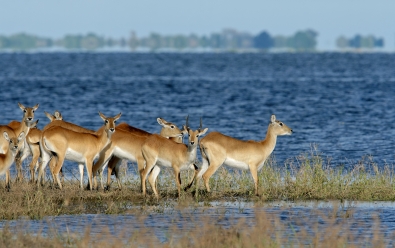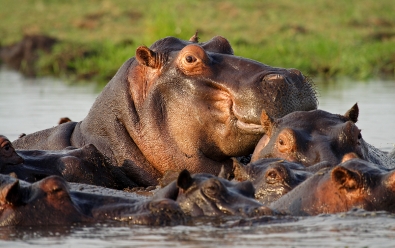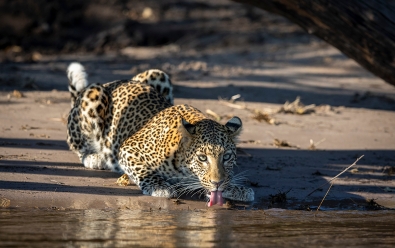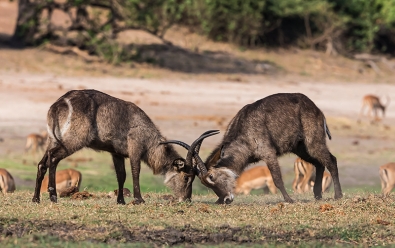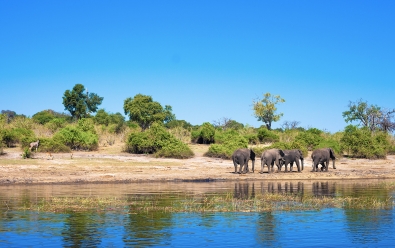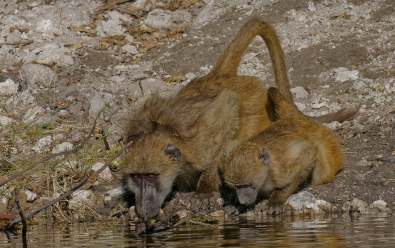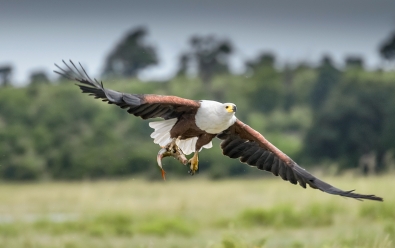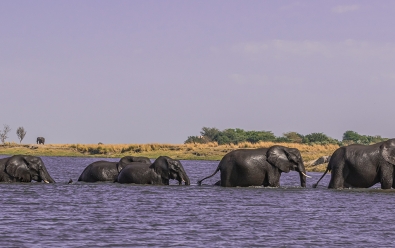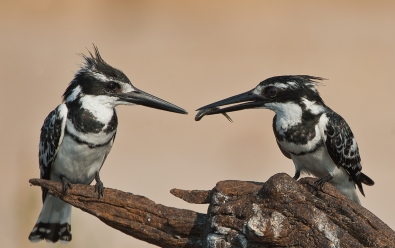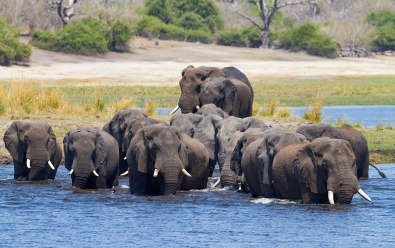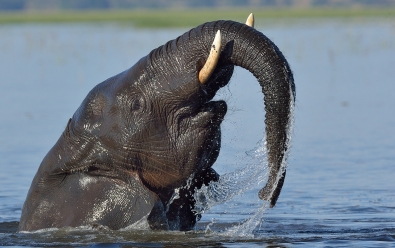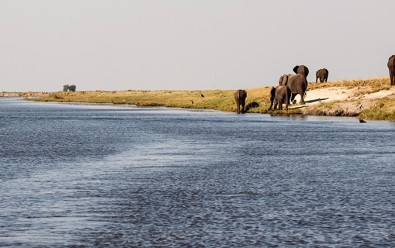Chobe Under Canvas
Highlights
- Rustic and authentic safari experience with all necessary comforts.
- Chobe Riverfront offers spectacularly good wildlife during dry season.
- Safaris on land and by boat along the game-rich Chobe River.
- Enjoy a photographic boat tour with all equipment provided.
Location
- Chobe Riverfront
- Chobe National Park
- Northern Botswana
Chobe Under Canvas offers a rustic, throwback safari experience just like traditional safaris of yesteryear, with simple but comfortable walk-in tents, bucket showers, and activities along the seasonally spectacular Chobe River.
The camp is technically a mobile operation, but is actually considered semi-permanent, as it remains in its location just north of Chobe National Park in a small wildlife concession on the banks of the Chobe River. Its prime location is the place to be during the dry season, when the area is a magnet for all of Chobe's wildlife, as it is the only place with fresh water for many miles around.
The camp's 5 Meru-style safari tents are spacious and comfortable, with 2 twins or a double bed, a separate toilet, and a bucket shower (hot water provided). The camp's main area is comprised of an open-sided canvas tent for dining and lounging and all meals are prepared over an open fire by the attentive staff.
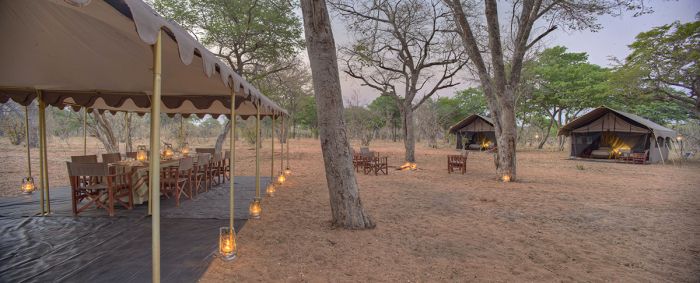
Main camp area and view to guest tents at Chobe Under Canvas.
There is no electricity and no W-Fi, which allows guests to disconnect from their everyday lives and enjoy a safari like those of yesteryear. Battery-powered and solar lighting is available to light the camp at night.
Activities include morning and afternoon drives in Chobe National Park and along the Chobe Riverfront, as well as boating on the Chobe River. A stay of at least 2 nights includes a half-day outing on a customized photographic safari boat with the use of top-range camera equipment included.
Wildlife along the Chobe River peaks between July and October, when the interior land in the national park had become completely dried. Elephants are present in huge numbers, with herds after herd drinking along the banks swimming in the river.
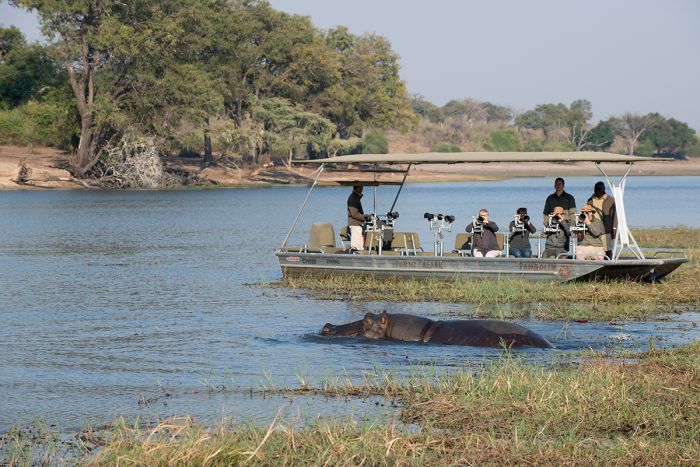
Photographic boating safari on the Chobe River.
Other wildlife present at this time includes buffalo, red lechwe, waterbuck, greater kudu, impala, zebra, and others. Predators seen regularly include lion, spotted hyena, African wild dog, and black-backed jackal. Leopard are seen on occasion. Hippo and crocodile are present in large numbers in the river. Birding along the river is also very good, with plenty of warbirds and raptors.
The further outside of the dry, peak season your stay, the less rewarding is the wildlife viewing and once the rains have arrived, the wildlife disperses into the core part of Chobe National Park.
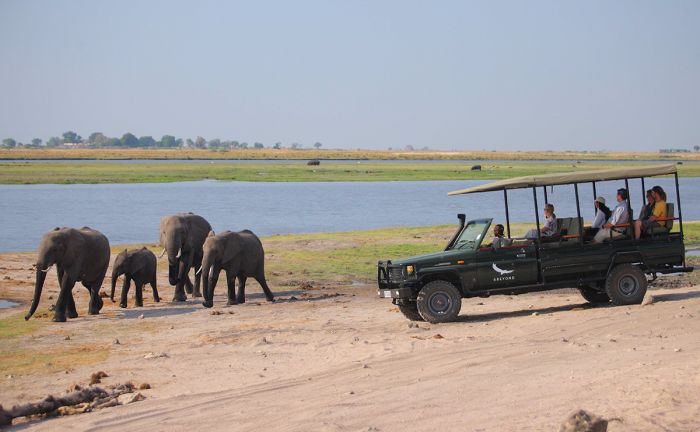
Game drive along the Chobe Riverfront.
About Chobe National Park
Chobe was the first national park (proclaimed in 1968) in Botswana and covers a massive 4 250 square miles (11 700 sq kms) of mostly dry habitat other than along its northern border (close to the Chobe River) and in the Savute Marsh (southwest Chobe).
The Chobe Riverfront and Savute Marsh offer the best wildlife viewing in the park and the permanent safari camps and lodges, as well as numerous public camping sites, are located almost exclusively in these two areas.
The majority of the national park is dominated by mixed woodland and Acacia scrub, with some areas of mature mopane tree forest. The northern border of the park, which is just south of the Chobe River is mostly floodplain grassland, while the Savute Marsh is fed by water from the Savuti Channel, which originates in the Linyanti Swamp.
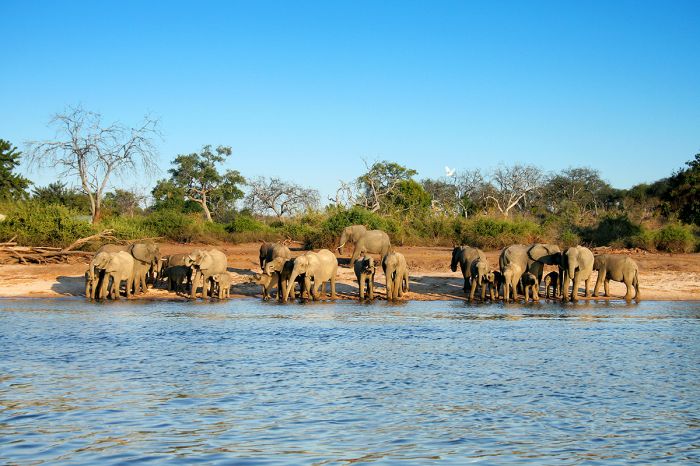
Elephants drinking at the Chobe River.
Chobe is situated atop the eastern extent of the Kalahari sands and there are some areas of vegetated sand ridges and dunes. The park also has many numerous pans that fill with water only during the rainy season between December and March. There are also some sand that have borehole pumps to help sustain the wildlife during the longer dry season.
During the dry season (July through October), Chobe's vast interior has little to no water, so the wildlife congregates along the Linyanti-Chobe river system, which forms the northern edge of the park. Safaris on the river during this are are spectacular, with hundreds of elephants visiting the rivers constantly.
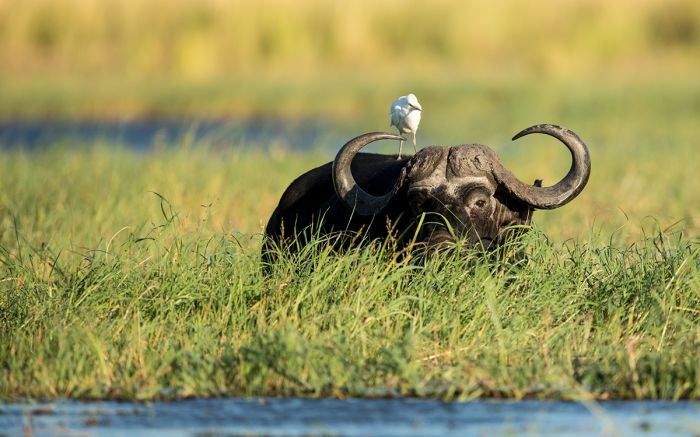
A buffalo on a small island in the Chobe River.
Buffalo, red lechwe, greater kudu, impala, tsessebe, giraffe, zebra, and warthog are common in Chobe and hippo and crocodile are found in large numbers in the rivers. Eland, roan, and sable are present in smaller numbers. The most common predators in Chobe are lion and spotted hyena. African wild dogs are seen regularly and leopard, cheetah, black-backed jackal, and side-striped jackal are found along the northern floodplains and in the Savute Marsh.
Like too many other places in Africa, rhinos once roamed throughout Chobe, but were sadly exterminated by hunters by the 1990s. Birding in Chobe is very good, especially along the rivers, which have an abundance of waterbirds, raptors, and passerines. The Savute March also offers excellent birding, dependent upon water levels. Over 450 species of bird have been recorded in Chobe.
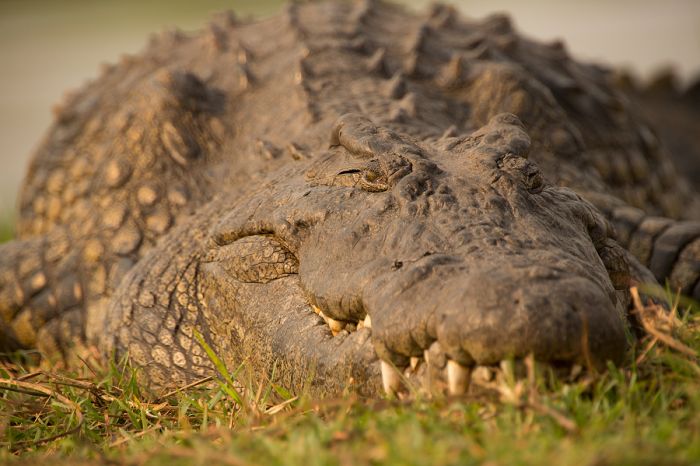
The Chobe River is home to many large Nile crocodiles that can be viewed up close from a boat.
About the Chobe Riverfront
The Chobe River forms the northern boundary of Botswana and is just north of the national park boundary, with a small wildlife concession between the two.
Lodges and safari camps located along the Chobe River starting just west of Kasane town offer boating safaris on the river, as well as game drives just south in Chobe National Park.
During the middle and latter part of the dry season, from July through October, the wildlife viewing on the banks of the Chobe River is nothing short of spectacular. Boat-based wildlife viewing is by far the best way to see the wildlife properly, and you will certainly see a lot.
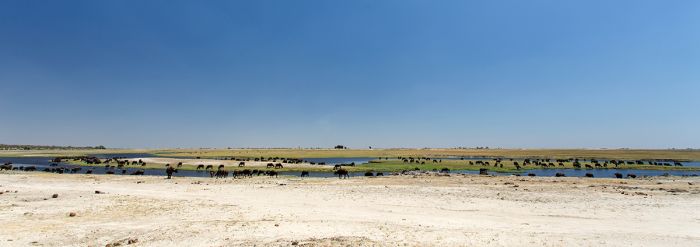
A massive herd of buffalo spread out along the Chobe Riverfront.
Hundreds of elephants can be seen in a day on the river, with herds coming to drink, swim, and play in the river, some crossing the river back and forth between Botswana and Namibia to the north. Other wildlife includes herds of buffalo and good numbers of red lechwe, greater kudu, impala, waterbuck, blue wildebeest, puku, bushbuck, and sometimes roan and sable.
Lion and African wild dog patrol the river bank and are seen regularly. Birding on the river is outstanding, with African fish eagles around every bend, plus plenty of herons, egrets, African skimmers, storks, kingfishers, and many more. Hippos are found along the banks in great numbers, as are Nile crocodiles, and both species can be seem up close from a boat while they sun themselves on the banks.
ROOMS INCLUDES & EXCLUDES CHILDREN FACILITIES ACTIVITIES
Accommodation
Chobe Under Canvas is a semi-permanent camp with 5 guest accommodations in total comprising:
- 5 comfortable canvas safari tents, each with two twin beds that are covetable to a double bed upon request (to be advised in advance).
Each guest tent is set up on the ground and has an en-suite bathroom with a separate flush toilet and indoor bucket shower (hot water provided upon request).
The tents are connected to the camp's main tented dining and lounge area by sandy footpaths on the ground.
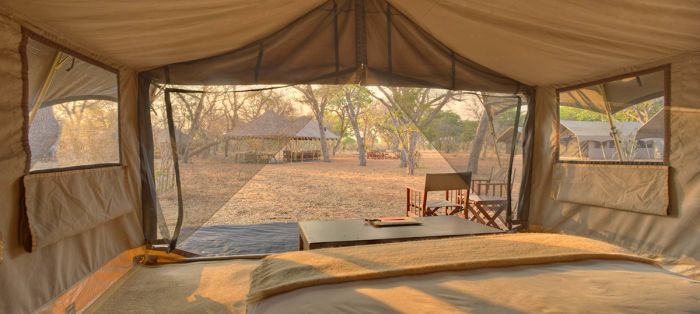
View from a guest tent at Chobe Under Canvas.
The Meru-style safari tents are perfect for those seeking a rustic safari like the days of old, but with all necessary comforts provided. There is a small seating area with table and chairs on the ground in front of the zip-up tent entrance.
Other items and features include:
- Battery-powered lighting in the tents.
- No Wi-Fi, so enjoy being disconnected from the everyday world.
- The campsites are not fenced off and guests need to be extremely vigilant at all times.
Chobe Under Canvas can accommodate a maximum of 10 guests in total: 2 persons in each of the 5 guest tents.
Includes & Excludes
Includes:
- All meals and local beverages including soft drinks, house wines, local brand spirits and beers, teas, and coffees.
- Safari experiences (twice-daily game drives in semi-open 4x4 vehicles and birding) accompanied by an experienced guide.
- One photographic safari on the Chobe River with Pangolin Photo Safaris, subject to a minimum of 2 night stay. This incredible half-day adventure will allow guests to capture the magnificent fauna and flora of the Chobe River, aboard a custom-built Pangolin photographic boat. Guests will be accompanied by experienced photographers, who will offer expert tips and recommendations on how to capture the most breath-taking images. Every seat on the boat is fitted with a top-of-the-range camera, which is fixed to a customized mount, so guests needn’t bring their own equipment.
- No laundry services; however guests will be provided with washing suds to do their laundry.
- A complimentary pair of Swarovski Optik CL Companion 8×30 binoculars per tent for use during your stay.
- Emergency medical evacuation insurance.
- Tourism Levy & VAT.
Excludes:
- Laundry.
- Any applicable wildlife fee, park fee, reserve fee, concession fee, other land-use fee.
Single Supplement
A single supplement may apply for any room booked by a single traveler; please ask us for pricing.
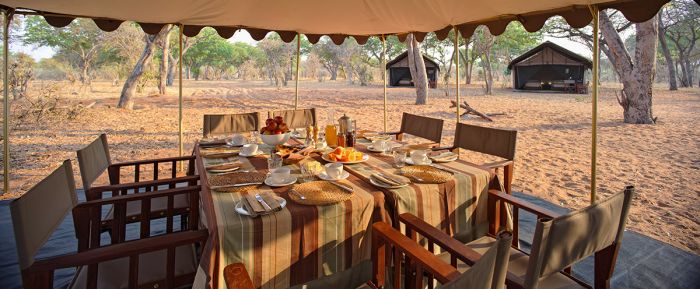
Main area dining at Chobe Under Canvas.
Children
Children aged 12 years and above are accommodated at Chobe Under Canvas:
- Triple tents are not available.
Facilities
- The common guest area comprises open-sided tents for dining, pre-dinner drinks, or simply whiling away the time between game viewing adventures with a good book and a beverage.
- Delicious and hearty meals are cooked by the staff over the open fire.
- No electricity, but solar-powered lights.
Activities
Activities included in the rate:
- Morning and afternoon game drives in semi-open 4x4 vehicles.
- The vehicles have 12-volt power for charging and a fridge for drinks and snacks while on drive.
- One photographic safari on the Chobe River with Pangolin Photo Safaris, subject to a minimum of 2 night stay. This incredible half-day adventure will allow guests to capture the magnificent fauna and flora of the Chobe River, aboard a custom-built Pangolin photographic boat. Guests will be accompanied by experienced photographers, who will offer expert tips and recommendations on how to capture the most breath-taking images. Every seat on the boat is fitted with a top-of-the-range camera, which is fixed to a customized mount, so guests needn’t bring their own equipment.
- Private activities are not offered.
- A complimentary pair of Swarovski Optik CL Companion 8×30 binoculars per tent for use during your stay.
- Birding.
- Stargazing.
Optional activities at additional cost:
- Boating trips beyond the included photographic outing detailed above. Best to pre-arrange this with us before traveling.
Chobe Riverfront
Great Good Fair Poor
- Jan
- Feb
- Mar
- Apr
- May
- Jun
- Jul
- Aug
- Sep
- Oct
- Nov
- Dec
Chobe Under Canvas is located at the Chobe Riverfront.
Savute Marsh
Great Good Fair Poor
- Jan
- Feb
- Mar
- Apr
- May
- Jun
- Jul
- Aug
- Sep
- Oct
- Nov
- Dec
When to Go
Chobe National Park offers good wildlife viewing opportunities throughout the year, but there are definitely seasonal variations in terms of weather and the densities of wildlife that may be a consideration when planning your visit.
The high season in terms of tourist demand is during the dry months between July and October, particularly along the Chobe Riverfront, which becomes a true wildlife spectacle with hundreds of elephants visiting the banks throughout the day.
Once the rains abate sometime in April, Chobe's waterholes becomes very dry, so most of the animals move north to the river. Some animals also move towards the Savute Marsh in the western part of the park.
The latter part of the rainy season (February through April) is the low season in general, although the lush grasslands around the Savute Marsh are full of zebras and blue wildebeest, which have migrated there for the fresh grasses beginning around late November and staying until the rains end.
Chobe Under Canvas operates year-round except for a week January, when it closes for maintenance.
SUMMER / RAINS
Northern Botswana, including Chobe National Park, receives most of its rain between December and February, which is the summer season. November and December are good months to visit the Savute Marsh area, with only occasional rainstorms and most rain coming in short showers, bringing welcome relief to the thirsty land after the dry season.
The rich grasslands around The Marsh turn green almost overnight after the first rains and the 'mini-migration' of zebras and blue wildebeests arrive between November and December in large numbers to graze on the new grasses. The is a lovely time to stay in The Marsh.
The Chobe Riverfront is not the place to visit once the rains arrive because the wildlife is able to disperse into the core of the park, where the rain pans are filling with water and plenty of new vegetation is available everywhere.
January and February typically experience afternoon downpours on most days, but all-day rains are uncommon. By the middle of March, the rains become much less frequent and the grass and bush have grown long and thick. Mornings become cooler by the end of March.
In spite of being summer, the rains keep temperatures from becoming overly hot, although humidity and insect life are at their peak. Days are mostly overcast or partially cloudy, with dramatic skies and a lovely green color to the landscape. Afternoon temperatures average 88°F (31°C), but mornings are very comfortable at around 65°F (19°C).
Baby animals are in abundance, especially impala lambs and warthog piglets. Migratory birds arrive to breed and dramatically increase the number of species and overall numbers, particularly in the lagoons and pans, which are full of rain water and food for the aquatic species.
Unlike the dry months (May through October), when the middays can be very warm, causing wildlife to minimize activity and seek shade from around 10am til mid-afternoon, the overcast skies during the summer often mean that animals are active throughout the day, offering many more hours of game viewing.
AUTUMN
March, April and May are Fall season months and the transition period toward the coming dry season in Chobe, with rains very uncommon from around mid-March. The landscape is still lush and green, with sunny days and comfortable temps; afternoons average 84°F (29°C). Mornings are comfortable, but a fleece and base layer may be needed for the first hours on game drive.
Migrant birds fly north and water in the lagoons and rain pans is drying up. Permanent waterways, including the Kwando, Linyanti, and Chobe rivers, are actually rising however, as the 'flood' water from the Angolan highlands is now reaching into northern Botswana. As a result of the rains abating and the waterholes away from the river becoming dry, animals begin to spend their time closer to these rivers, and wildlife sightings become better and better.
Morning temps are around 54°F/12°C and afternoons average 79°F/26°C.
WINTER / DRY SEASON
June through August is winter and the vegetation is drying and going dormant. The water in the Linyanti/Chobe river system is peaking, but the surrounding landscape is mostly brown and yellow. Dust and sand particles in the air is on the rise. Game viewing along the Chobe Riverfront is becoming better and by July, the river and floodplains are absolutely pumping with wildlife, with elephant and buffalo herds congregating in great numbers.
Mornings can be chilly to very cold at around 45°F (7°C). Warm clothes, including winter hat and gloves are needed for the open-air game drives. Dress in layers, as the temps do rise quickly during the day, with middays reaching 79°F (26°C).
Wildlife sightings along the Chobe Riverfront are non-stop boat-based safaris are the best way to see the wildlife. Elephants are around every bend and even swim back and forth across the river to Namibia and back. July through October on the Chobe River is simply outstanding for safaris.
SPRING
September and October are the driest months as the landscape and animals eagerly await the coming rains. Game viewing in both The Savute Marsh and Chobe Riverfront is phenomenal, with all rain pans now completely dry and animals congregating around the only places in Chobe where permanent water can be found.
Days are warm, sunny, and often cloudless and by mid-morning, most animals are seeking shelter in the shade and awaiting the evening temps to drop. October can be brutally hot and dusty and even smoky as sporadic grass fires can occur.
Safari camps are mostly full to capacity. Temperatures in October can easily reach 95°F (35°C) or even hotter.




